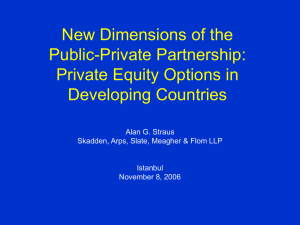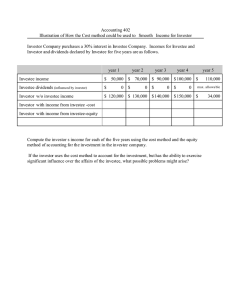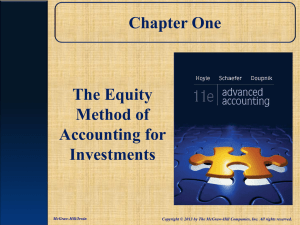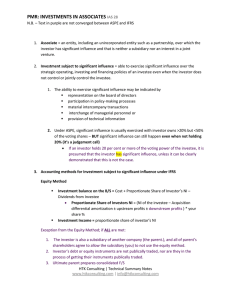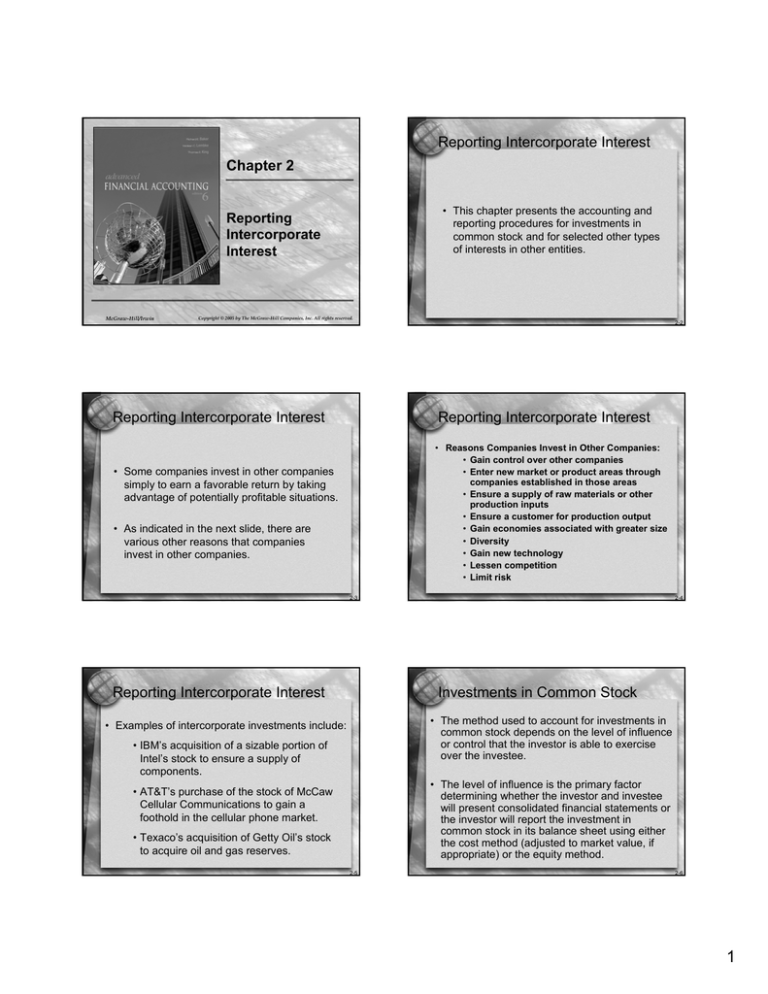
Reporting Intercorporate Interest
Chapter 2
• This chapter presents the accounting and
reporting procedures for investments in
common stock and for selected other types
of interests in other entities.
Reporting
Intercorporate
Interest
McGraw-Hill/Irwin
Copyright © 2005 by The McGraw-Hill Companies, Inc. All rights reserved.
Reporting Intercorporate Interest
2-2
Reporting Intercorporate Interest
• Reasons Companies Invest in Other Companies:
• Gain control over other companies
• Enter new market or product areas through
companies established in those areas
• Ensure a supply of raw materials or other
production inputs
• Ensure a customer for production output
• Gain economies associated with greater size
• Diversity
• Gain new technology
• Lessen competition
• Limit risk
• Some companies invest in other companies
simply to earn a favorable return by taking
advantage of potentially profitable situations.
• As indicated in the next slide, there are
various other reasons that companies
invest in other companies.
2-3
Reporting Intercorporate Interest
2-4
Investments in Common Stock
• The method used to account for investments in
common stock depends on the level of influence
or control that the investor is able to exercise
over the investee.
• Examples of intercorporate investments include:
• IBM’s acquisition of a sizable portion of
Intel’s stock to ensure a supply of
components.
• The level of influence is the primary factor
determining whether the investor and investee
will present consolidated financial statements or
the investor will report the investment in
common stock in its balance sheet using either
the cost method (adjusted to market value, if
appropriate) or the equity method.
• AT&T’s purchase of the stock of McCaw
Cellular Communications to gain a
foothold in the cellular phone market.
• Texaco’s acquisition of Getty Oil’s stock
to acquire oil and gas reserves.
2-5
2-6
1
Investments in Common Stock
Investments in Common Stock
• Consolidation is normally appropriate where one
company, referred to as the parent, controls
another company, referred to as the subsidiary.
• Consolidation involves the combining for
financial reporting the individual assets,
liabilities, revenues, and expenses of two or
more related companies as if they were part
of a single company.
• An unconsolidated subsidiary should be
reported as an investment on the parent’s
balance sheet. Unconsolidated subsidiaries are
relatively rare.
• This process includes the elimination of all
intercompany ownership and activities (such
as intercompany sales and purchases, and
intercompany loans).
• The specific requirements for consolidation are
discussed in Chapter 3.
2-7
Investments in Common Stock
2-8
Investments in Common Stock
• The equity method is used for external reporting
when the investor exercises significant influence
over the operating and financial policies of the
investee and consolidation is not appropriate.
• The cost method is used for reporting
investments in nonmarketable equity securities
when both consolidation and equity method
reporting are inappropriate.
• The equity method may not be used in place of
consolidation when consolidation is appropriate,
and therefore its primary use is in reporting
nonsubsidiary investments.
• For marketable equity securities, when both
consolidation and equity method reporting are
inappropriate, the investment is normally
accounted for using the cost method and
adjusted to market value under FASB 115.
• The equity method is used most often when one
company holds between 20 and 50 percent of
another company’s common stock.
• FASB 115 is not applicable to equity method
investments.
2-9
Accounting During the Year
Versus Reporting at Year End
2-10
Accounting During the Year Versus
Reporting at Year End--Continued
• Under normal circumstances, companies
using the cost or equity for financial reporting
purposes “at year end” also use that method
for accounting for the investment on their
books “during the year.”
• When consolidated financial statements are
prepared for financial reporting purposes “at
year end,” the parent still must account for the
investment in the subsidiary ”during the year”
(on its books) using the cost or equity method
even though the intercorporate investment and
related income must be eliminated in preparing
the consolidated statements “at year end.”
• As discussed next, this is not the case with
respect to companies required to consolidate
their investments in subsidiaries for financial
reporting purposes.
2-11
2-12
2
Cost Method—
Influence Not Significant (0 to 20 percent)
Cost Method—
Influence Not Significant (0 to 20 percent)
• Intercorporate investments accounted for by
the cost method are carried by the investor at
historical cost.
• At the time of purchase, the investor records its
investment in common stock at the total cost
incurred in making the purchase.
• Income is recorded by the investor when
dividends are declared by the investee.
• After the time of purchase, the carrying amount
of the investment (i.e., the original cost) remains
unchanged under the cost method until the time
of sale (or unless there is a liquidating
dividend—more on this later).
• The cost method is used when the investor
lacks the ability either to control or to exercise
significant influence over the investee.
2-13
Cost Method—
Influence Not Significant (0 to 20 percent)
• Once the investee declares a dividend, the
investor has a legal claim against the investee
for a proportionate share of the dividend and
realization of the income is considered certain
enough to be recognized.
2-14
Cost Method—Example
• ABC Company purchases 20 percent of XYZ
Company’s common stock for $100,000 at the
beginning of the year but does not gain
significant influence over XYZ.
Investment in XYZ
Company Stock
Cash
• Recognition of investment income before a
dividend declaration is considered inappropriate
because the investee’s income is not available
to the owners until a dividend is declared—
dividends do not accrue!!!
$100,000
$100,000
2-15
Cost Method—Example
Cost Method—Liquidating Dividends
• During the year, XYZ has net income of
$50,000 and pays dividends of $20,000.
Cash ($20,000 X .20)
Dividend Income
2-16
• All dividends declared by the investee--in
excess of its earnings since acquisition by
the investor--are viewed by the investor as
liquidating dividends.
$4,000
$4,000
• In the previous example, if XYZ had no
earnings, all dividends would have been
viewed by ABC as liquidating dividends.
[Continued on next slide.]
NOTE: Liquidating dividends
are discussed next.
2-17
2-18
3
Cost Method—Liquidating Dividends
• APB 18 (as amended) provides the professional
guidance regarding the equity method. The
equity method of accounting for intercorporate
investments in common stock is intended to
reflect the investor’s changing equity or interest
in the investee.
• In turn, “Investment in XYZ Company Stock”
would be credited in lieu of “Dividend Income.”
• Cash ($20,000 X .20)
The Equity Method—
Significant Influence (20 to 50 percent)
$4,000
Investment in XYZ
Common Stock
• The equity method is a rather curious one in that
the balance in the investment account generally
does not reflect either cost or market value, nor
does the balance necessarily represent a pro
rata share of the investee’s book value.
$4,000
2-19
The Equity Method—
Significant Influence (20 to 50 percent)
2-20
The Equity Method—
Significant Influence (20 to 50 percent)
• Under the equity method, the investor records its
investment at the original cost.
• This amount is adjusted periodically for changes
in the investee’s stockholders’ equity occasioned
by the investee’s profits (or losses) and dividend
declarations.
• Reported by Investee:
• Effect On Investor:
– Net Income (Loss)
– Record income (loss)
from investment and
increase (decrease)
investment account.
– Dividend Declaration
– Record asset (cash
or receivable) and
decrease investment
account.
2-21
The Equity Method—Equity Accrual
Equity Method—Significant Influence
• Because of the ability to exercise significant
influence over the policies of the investee,
realization of income from the investment is
considered to be sufficiently assured to
warrant recognition by the investor as the
income is earned by the investee.
• Assume ABC Company acquires significant
influence over XYZ Company by purchasing
20 percent of the common stock of the XYZ
Company at the beginning of the year. XYZ
Company reports income for the year of
$60,000. ABC records its $12,000 share of
XYZ’s income with the following entry:
Investment in XYZ
Company Stock ($60,000 X .2)
Income from Investee
2-22
• This differs from the case in which the investor
does not have the ability to significantly
influence the investee and the investment must
be reported using the cost method; in that case,
income form the investment is recognized only
upon declaration of a dividend by the investee.
$12,000
$12,000
2-23
2-24
4
Equity Method—Recognition of Dividends
Equity Method—Recognition of Dividends
• In effect, all dividends from the investee are
treated as liquidating dividends under the
equity method. Thus, if ABC Company owns
20 percent of XYZ’s common stock and XYZ
declares and pays a $20,000 dividend, the
following entry is recorded on the books of
ABC to record its share of the dividend:
• Dividends from an investment are not
recognized as income under the equity
method because the investor’s share of
the investee’s income is recognized as
it is earned by the investee.
• Instead, such dividends are viewed as
distributions of previously recognized
income that already has been capitalized
in the carrying amount of the investment.
Cash ($20,000 X .20)
Investment in XYZ
Company Stock
$4,000
$4,000
2-25
Equity Method—
Acquisition at Interim Date
2-26
Equity Method—
Acquisition at Interim Date (Continued)
• When the purchase occurs between balance
sheet dates, the amount of income earned by
the investee from the date of the acquisition to
the end of the fiscal period may need to be
estimated by the investor in recording the equity
accrual.
• When an investment is purchased, the investor
begins accruing income from the investee under
the equity method at the date of acquisition.
• No income earned by the investee before the
date of acquisition of the investment may be
accrued by the investor.
• For example, if the acquisition (20 percent
interest) was transacted on October 31 and the
investee earned $60,000 for the entire year, the
investor would have an equity accrual of $3,000
(i.e., $60,000 X .20 X 3/12 = $3,000).
2-27
Equity Method—
Acquisition at Interim Date (Continued)
2-28
Investment Cost Versus
Underlying Book Value
• When one corporation buys the common stock
of another, the purchase price normally is based
on the market price of the shares acquired
rather than the book values of the investee’s
assets and liabilities.
• WARNING: Watch out for “liquidating
dividends” when acquisitions
are transacted at interim dates.
• As a result, there often is a difference between
the cost of the investment to the investor and the
book value of the investor’s proportionate share
of the underlying net assets of the investee.
• This difference is referred to as a differential.
2-29
2-30
5
Investment Cost Versus
Underlying Book Value
Investment Cost Versus
Underlying Book Value
• The differential represents the amount paid by
the investor in excess of the book value of the
investment and is included in the investment
amount.
• There are several reasons the cost of an
investment might exceed the book value
of the underlying net assets and give rise
to a positive differential.
• Hence, the amortization or reduction of the
differential involves the reduction of the
investment account.
• One reason is that the investee’s assets
may be worth more than their book value.
• At the same time, the investor’s net income must
be reduced by an equal amount to recognize
that a portion of the amount paid for the
investment has expired.
• Another reason could be the existence of
unrecorded goodwill associated with the
excess earning power of the investee.
2-31
Investment Cost Versus
Underlying Book Value
2-32
Investment Cost Versus
Underlying Book Value
• Purchase differentials related to a limited life
asset (e.g., equipment) should be amortized
over the life of the related asset.
• To record equity method income
of $9,000 (assumed).
Investment in Investee Company
Income from Investee Company
• If the purchase differential has a debit balance,
the equity method entry to amortize the
purchase differential will be the opposite of the
“equity accrual” entry, that is, with respect to the
accounts debited or credited.
$9,000
$9,000
• To amortize debit purchase
differential of $4,000 (assumed).
Income from Investee Company
$4,000
Investment in Investee Company
$4,000
• Examples are provided on next slide.
2-33
Investment Cost Versus
Underlying Book Value
2-34
Disposal of Differential-Related Assets
• Any portion of the differential that is related to
land is not amortized since land has an unlimited
life.
• Any portion of the differential that represents
goodwill (referred to as equity method goodwill)
is neither amortized nor written down for
impairment.
• If the investee disposes of any asset to which
the differential relates, that portion of the
differential must be removed from the
investment account on the investor’s books.
• When this is done, the investor’s share of the
investee’s gain or loss on disposal of the asset
must be adjusted to reflect the fact that the
investor paid more for its proportionate share of
that asset than did the investee.
• However, an impairment loss on the investment
itself should be recognized if it suffers a decline
in the value that is other than temporary.
2-35
2-36
6
Impairment of Investment Value
Impairment of Investment Value-con’d
• As with many assets, accounting standards
require that equity-method investments be
written down if their value is impaired.
• The new lower value serves as a starting
point for continued application of the equity
method.
• If the market value of the investment declines
materially below its equity-method carrying
amount, and the decline in value is considered
other than temporary, the carrying amount of
the investment should be written down to the
market value and a loss recognized.
• Subsequent recoveries in the value of the
investment may not be recognized.
2-37
Changes in Number of Shares Held
2-38
Purchases of Additional Shares
• A purchase of additional shares of common
stock already held by an investor and
accounted for using the equity method simply
involves adding the cost of the new shares to
the investment account and applying the equity
method in the normal manner from the date of
acquisition forward. The new and old
investments in the same stock are combined
for financial reporting purposes.
• A change in the number of common shares
held by an investor resulting from a stock
dividend, split, or reverse split is treated in
the same way as under the cost method. No
formal accounting recognition is required on
the books of the investor.
• On the other hand, purchases and sales of
shares do require formal recognition.
• Income accruing to the new shares can be
recognized by the investor only from the date
of acquisition forward.
2-39
Determination of Significant Influence
• The general rule established in APB 18 is that
the equity method is appropriate where the
investor, by virtue of its common stock interest
in an investee, is able to exercise significant
influence over the operating and financial
policies of the investee.
2-40
Investments in Partnerships
• Pronouncements of the FASB generally relate
to corporations rather than partnerships. Thus,
companies holding equity investments in
partnerships generally have more flexibility but
less guidance in reporting their investments.
• In the absence of other evidence, common
stock ownership of 20 percent or more is viewed
as indicating that the investor is able to exercise
significant influence over the investee.
2-41
• Companies with ownership interests in
partnerships typically choose one of the
following methods for reporting investments:
cost method, equity method, consolidation, or
pro-rata consolidation.
2-42
7
Unrealized Intercompany Profits
Unrealized Intercompany Profits
• Under APB 18, intercompany sales do not
result in the realization of income until the
intercompany profit is confirmed in some way,
usually through a transaction with an unrelated
party. Thus, unrealized intercompany profits
must be eliminated from both consolidated
financial statement amounts as well as equity
method amounts.
• Unrealized intercompany profits overstate
earnings. Thus the equity method entry to
remove the unrealized profit will be the
opposite of the “equity accrual” entry, that
is, with respect to the accounts debited or
credited.
• The term for the application of the equity
method that includes the adjustment for
unrealized intercompany profits is “fully
adjusted equity method.”
• Examples are provided on the next slide.
2-43
Unrealized Intercompany Profits
Chapter Three to Chapter Ten
• To record equity method income of $9,000
(assumed).
Investment in Investee Company
Income from Investee Company
2-44
• Three different approaches are followed by
companies (in practice) in accounting for their
consolidated subsidiary during the year:
$9,000
$9,000
• The fully adjusted equity method
(a.k.a., the equity method).
• To remove unrealized intercompany profit of
$2,000 (assumed).
Income from Investee Company
$2,000
Investment in Investee Company
$2,000
• The basic equity method.
• The cost method.
2-45
Chapter Three to Chapter Ten
2-46
Chapter Three to Chapter Ten
• In essence, the basic equity method is a
modified version of the equity method
discussed in this chapter.
• The cost method and the fully adjusted
equity method (a.k.a., the equity method)
were previously discussed in this chapter.
• Specifically, the basic equity method avoids
“unrealized profit transactions” that will be
eliminated during the consolidation process.
• The basic equity method is used in Chapters
3 to 10 and is discussed in the next slide.
• While the basic equity method is “Not GAAP,”
use of the basic equity method may help
provide some “clerical savings” for the parent
company—as well as students and teachers.
2-47
2-48
8
You Will Survive Chapter 2 !!!
You Will Survive Chapter 2 !!!
• There are two sets of accounting
records (i.e., books) to analyze.
• If consolidation is required, the investor may
be referred to as the “parent company” and
the investee may be referred to as the
“subsidiary” company.
• You should always ask yourself –
does the information relate to the
investor or the investee or both ?
2-49
You Will Survive Chapter 2 !!!
2-50
You Will Survive Chapter 2 !!!
• The cost method and the equity method are
both accounting methods and reporting
methods, that is, they are used during the
year as well as at year-end, respectively.
• There is only one “trick” to the cost
method—liquidating dividends.
• Unless consolidation is required, the investor
would usually use the same method for
accounting and reporting purposes.
• Remember—dividends do not accrue.
• Remember—only use post-acquisition
earnings.
• If consolidation is required, all balances related
to either the cost method or the equity method
are eliminated when preparing the consolidated
financial statements—thus either method may
be used during the year.
2-51
2-52
You Will Survive Chapter 2 !!!
Chapter 2
• Think of the equity method in terms of three
levels (and start with the bottom level):
Reporting
Intercorporate
Interest
• Top level--Unrealized profits
• Middle level—Differential
• Base or bottom level--Book value
2-53
McGraw-Hill/Irwin
Copyright © 2005 by The McGraw-Hill Companies, Inc. All rights reserved.
9
McGraw-Hill/Irwin
Chapter 2
Chapter 2
Reporting
Intercorporate
Interest
End of Chapter
Copyright © 2005 by The McGraw-Hill Companies, Inc. All rights reserved.
McGraw-Hill/Irwin
Copyright © 2005 by The McGraw-Hill Companies, Inc. All rights reserved.
10


